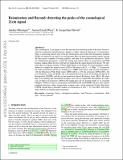Reionization and beyond: detecting the peaks of the cosmological 21 cm signal
Author(s)
Mesinger, Andrei; Ewall-Wice, Aaron Michael; Hewitt, Jacqueline N
Download1310.0465.pdf (2.294Mb)
Terms of use
Metadata
Show full item recordAbstract
The cosmological 21 cm signal is set to become the most powerful probe of the early Universe, with first-generation interferometers aiming to make statistical detections of reionization. There is increasing interest also in the pre-reionization epoch when the intergalactic medium (IGM) was heated by an early X-ray background. Here, we perform parameter studies varying the halo masses capable of hosting galaxies and their X-ray production efficiencies. These two fundamental parameters control the timing and relative offset of reionization and IGM heating, making them the most relevant for predicting the signal during both epochs. We also relate these to popular models of warm dark matter cosmologies. For each parameter combination, we compute the signal-to-noise ratio (S/N) of the large-scale (k similar to 0.1 Mpc(-1)) 21 cm power for both reionization and X-ray heating for a 2000 h observation with several instruments: 128 tile Murchison Wide Field Array (MWA128T), a 256 tile extension (MWA256T), the Low Frequency Array (LOFAR), the 128 element Precision Array for Probing the Epoch of Reionization (PAPER), and the second-generation Square Kilometre Array (SKA). We show that X-ray heating and reionization in many cases are of comparable detectability. For fiducial astrophysical parameters, MWA128T might detect X-ray heating, thanks to its extended bandpass. When it comes to reionization, both MWA128T and PAPER will also only achieve marginal detections, unless foregrounds on larger scales can be mitigated. On the other hand, LOFAR should detect plausible models of reionization at S/N > 10. The SKA will easily detect both X-ray heating and reionization. Keywords: galaxies: high-redshift; intergalactic medium; dark ages; reionization; first stars; diffuse radiation; early Universe; X-rays: diffuse background
Date issued
2014-02Department
MIT Kavli Institute for Astrophysics and Space ResearchJournal
Monthly Notices of the Royal Astronomical Society
Publisher
Oxford University Press (OUP)
Citation
Mesinger, Andrei et al. “Reionization and Beyond: Detecting the Peaks of the Cosmological 21 Cm Signal.” Monthly Notices of the Royal Astronomical Society 439, 4 (February 2014): 3262–3274 © 2014 The Authors
Version: Author's final manuscript
ISSN
1365-2966
0035-8711
Collections
The following license files are associated with this item: